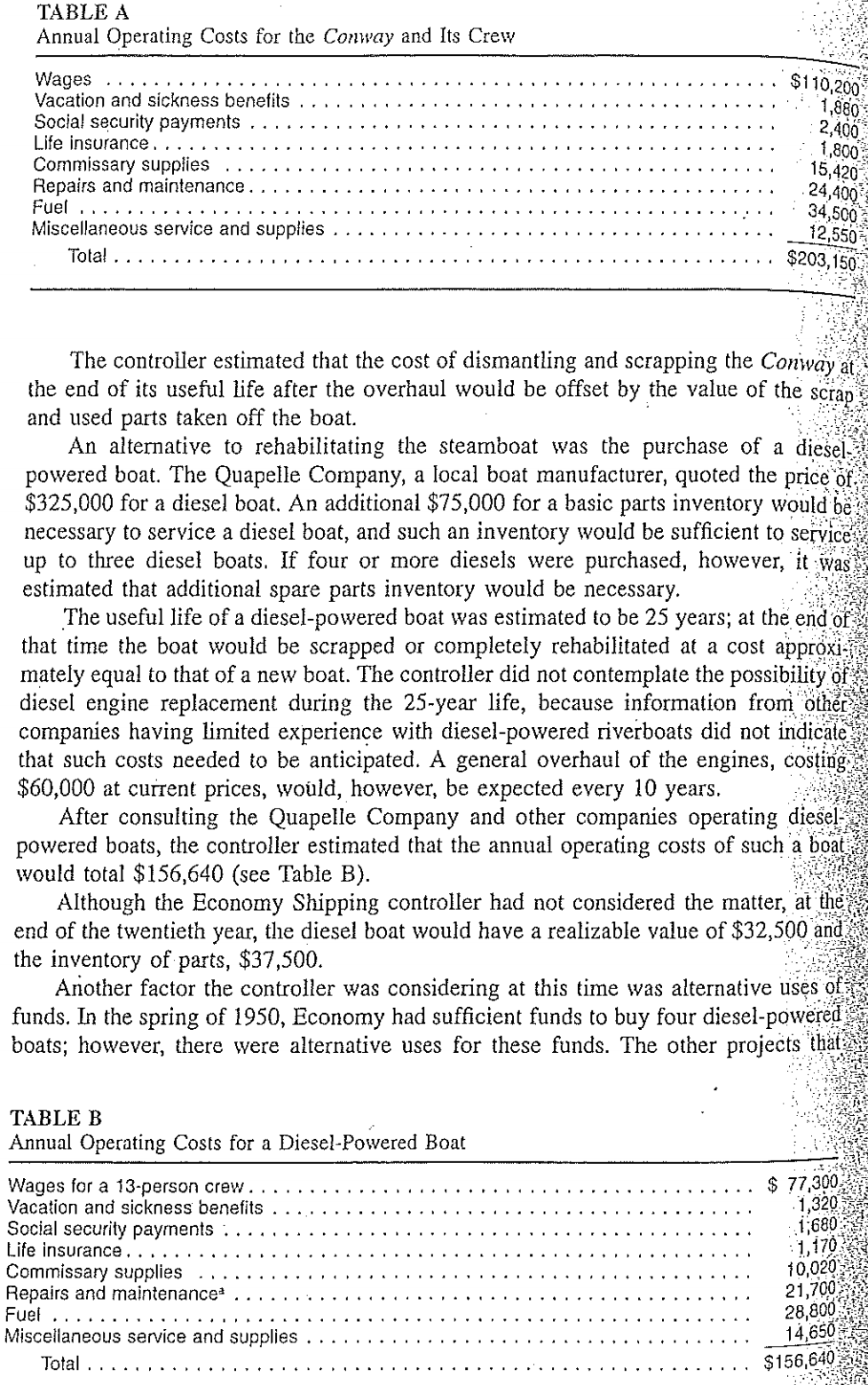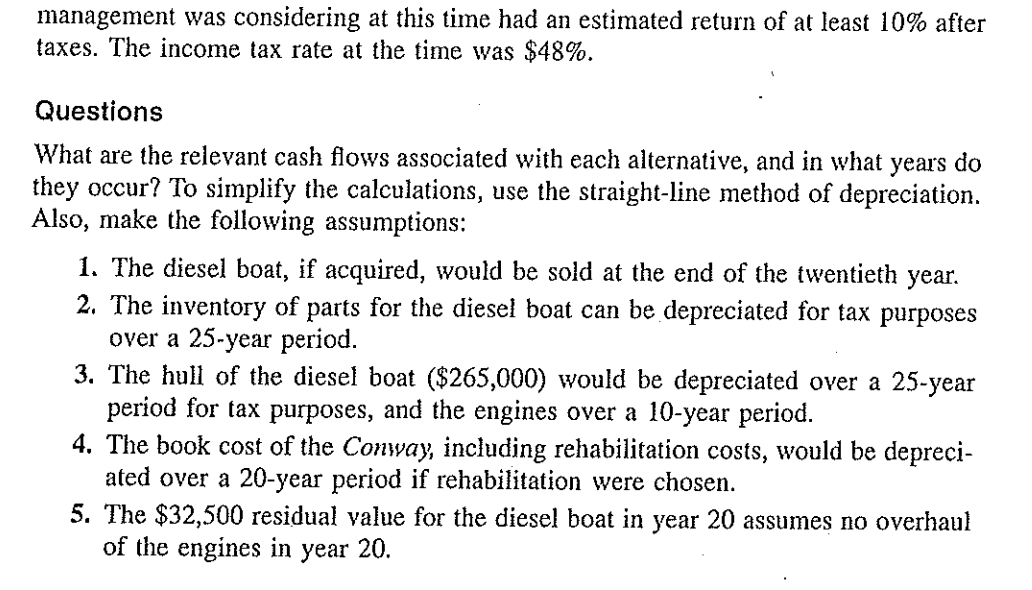Calculate the additional initial outlay associated with purchasing the new diesel boat. (In other words, calculate the incremental difference in the cash flows between the initial outlay associated with purchasing the diesel boat and the initial outlay associated with renovating the Conway.)
Calculate the additional depreciation associated with purchasing the new diesel boat. (In other words, calculate the incremental difference in the depreciation associated with purchasing the diesel boat and the depreciation associated with renovating the Conway.)
Calculate the additional operating cash flows (i.e., cost savings) associated with purchasing the new diesel boat (which will occur in all years except Year 10). In other words, calculate the incremental difference between the annual operating cash flows associated with purchasing the diesel boat and the annual operating cash flows associated with renovating the Conway.
Calculate the additional terminal cash flows associated with purchasing the new diesel boat. (In other words, calculate the incremental difference in the cash flows between the terminal cash flows associated with purchasing the diesel boat and the terminal cash flows associated with renovating the Conway.)
Calculate the NPV for the project of purchasing the new diesel boat.
Based on your NPV calculation, what should be the conclusion about purchasing the new diesel boat?
Select one:
a. Accept
b. Reject



Economy Shipping Company (Abridged) In the spring of 1950 the controller of Economy Shipping Company, located near Pittsburgh, was preparing a report for the executive committee regarding the feasibility of repairing one of the company's steam riverboats or of replacing the steamboat with a new diesel-powered boat, The Economy Shipping Company was engaged mainly in the transportation of coal from the nearby mines to the steel mills, public utilities, and other industries in the Pittsburgh area. Occasionally, the company's several steamboats also carried cargoes to places as far away as New Orleans. The boats owned by Economy Shipping were all steam powered. All were at least 10 years old, and the majority of them were between 15 and 30 years old. The steamboat the controller was concerned about, the Conway, was 23 years old and required immediate rehabilitation or replacement. It was estimated that the Con- way had a useful life of another 20 years provided that adequate repairs and mainte- nance were made. The book value of the Conway was $39,500, but the controller believed that if the company sold the boat in 1950, it would bring only around $25,000. The immediate rehabilitation costs for the Conway were estimated to be $115,000. The controller estimated that these general rehabilitation expenditures would extend the useful life of the Conway for about 20 years. New spare parts from another boat, which had been retired in 1948, were available for use in the rehabilitation of the Conway. If these parts were used on the Comway, an estimate of their fair value was $43,500, which was their book value. Use of these parts would, in effect, decrease the immediate rehabilitation costs from $115,000 to $71,500. It was believed that if these parts were sold on the market they would bring only around $30,000. They could not be used on any of the other Economy Shipping steamboats. Currently, the Conway was operated by a crew of 20. Annual operating costs for the 20-person crew are shown in Table A. TABLE A Annual Operating Costs for the Conway and Its Crew Wages Vacation and sickness benefits Social security payments Life insurance. Commissary supplies Repairs and maintenance Fuel Miscellaneous service and supplies Total . . . . $110,200 1,880 2,400 1,800 15,4207 24,400 34,500 12,5503 $203,150 The controller estimated that the cost of dismantling and scrapping the Conway at the end of its useful life after the overhaul would be offset by the value of the scrap and used parts taken off the boat. An alternative to rehabilitating the steamboat was the purchase of a diesel. powered boat. The Quapelle Company, a local boat manufacturer, quoted the price of $325,000 for a diesel boat. An additional $75,000 for a basic parts inventory would be necessary to service a diesel boat, and such an inventory would be sufficient to service up to three diesel boats. If four or more diesels were purchased, however, it was estimated that additional spare parts inventory would be necessary. The useful life of a diesel-powered boat was estimated to be 25 years; at the end of that time the boat would be scrapped or completely rehabilitated at a cost approxi: mately equal to that of a new boat. The controller did not contemplate the possibility of diesel engine replacement during the 25-year life, because information from other companies having limited experience with diesel-powered riverboats did not indicale that such costs needed to be anticipated. A general overhaul of the engines, costing. $60,000 at current prices, would, however, be expected every 10 years. After consulting the Quapelle Company and other companies operating diesel- powered boats, the controller estimated that the annual operating costs of such a boat would total $156,640 (see Table B). Although the Economy Shipping controller had not considered the matter, at the end of the twentieth year, the diesel boat would have a realizable value of $32,500 and the inventory of parts, $37,500. Another factor the controller was considering at this time was alternative uses of funds. In the spring of 1950, Economy had sufficient funds to buy four diesel-powered boats; however, there were alternative uses for these funds. The other projects that TABLE B An ial Operating Costs for a Dies Powered Boat Wages for a 13-person crew. Vacation and sickness benefits Social security payments Life insurance.. Commissary supplies Repairs and maintenancea Fuel Miscellaneous service and supplies Total . ... $ 77,300. 1,320 1,680 1,170 10,020 21,700 28,800 14,650 $156,640 management was considering at this time had an estimated return of at least 10% after taxes. The income tax rate at the time was $48%. Questions What are the relevant cash flows associated with each alternative, and in what years do they occur? To simplify the calculations, use the straight-line method of depreciation. Also, make the following assumptions: 1. The diesel boat, if acquired, would be sold at the end of the twentieth year. 2. The inventory of parts for the diesel boat can be depreciated for tax purposes over a 25-year period. 3. The hull of the diesel boat ($265,000) would be depreciated over a 25-year period for tax purposes, and the engines over a 10-year period. 4. The book cost of the Conway, including rehabilitation costs, would be depreci- ated over a 20-year period if rehabilitation were chosen. 5. The $32,500 residual value for the diesel boat in year 20 assumes no overhaul of the engines in year 20









